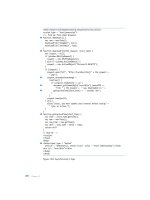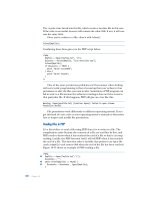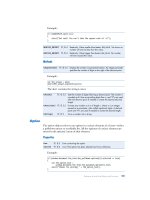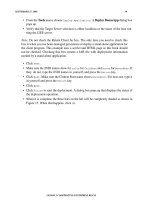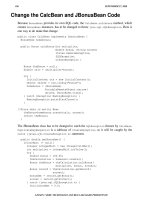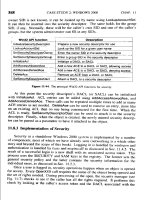Java Server Pages 2nd Edition phần 10 ppsx
Bạn đang xem bản rút gọn của tài liệu. Xem và tải ngay bản đầy đủ của tài liệu tại đây (420.28 KB, 2 trang )
Appendix D. JSP API Reference
549
double quotes, slashes, question marks, at signs, colons, and semicolons. Empty
values may not behave the same way on all browsers.
public void setVersion(int version)
Sets the version of the cookie protocol this cookie complies with. A value of 0 means
that the cookie must be sent to the browser as described by the original Netscape
specification; 1 that the cookie must be sent as defined by RFC 2109.
RequestDispatcher
The RequestDispatcher class defines an object that receives requests from the client and
sends them to any resource (such as a servlet, HTML file, or JSP file) in the same web
container. The container creates the RequestDispatcher object, which is used as a
wrapper around a resource located at a particular URI path or identified by a particular name.
Synopsis
Interface name:
javax.servlet.RequestDispatcher
Extends: None
Implemented by: Internal container-dependent class.
Methods
public void forward(ServletRequest req, ServletResponse res)
Forwards a request from a servlet to another resource (servlet, JSP file, or HTML file)
on the server. For a RequestDispatcher obtained via
getRequestDispatcher( ), the ServletRequest object has its path elements
and parameters adjusted to match the path of the target resource.
This method must be called before the response has been committed to the client
(before response body output has been flushed). If the response has already been
committed, this method throws an
IllegalStateException. Uncommitted output
in the response buffer is automatically cleared before the forward.
The request and response parameters must be the same objects as were passed to the
calling servlet's service method or be subclasses of the ServletRequestWrapper
or ServletResponseWrapper classes that wrap them.
public void include(ServletRequest req, ServletResponse res)
Includes the response generated by a resource (servlet, JSP page, HTML file) in the
response.
Appendix D. JSP API Reference
550
The ServletResponse object's path elements and parameters remain unchanged
from the caller's. The included servlet can't change the response status code or set
headers; any attempt to make a change is ignored.
The request and response parameters must be the same objects that were passed to the
calling servlet's service method or be subclasses of the ServletRequestWrapper
or ServletResponseWrapper classes that wrap them.
D.3 Tag Handler Types
The JSP specification defines a number of classes and interfaces in the
javax.servlet.jsp.tagext package. These classes are used to develop tag handler
classes for JSP custom actions. This section contains descriptions of each class and interfaces.
Chapter 20 and Chapter 21 show examples of how you can use these classes and interfaces to
develop custom actions.
BodyContent
The container creates an instance of the BodyContent class to encapsulate the element body
of a custom action element if the corresponding tag handler implements the BodyTag
interface. The container makes the BodyContent instance available to the tag handler by
calling the setBodyContent( ) method, so the tag handler can process the body content.
Synopsis
Class name:
javax.servlet.jsp.tagext.BodyContent
Extends:
javax.servlet.jsp.JspWriter
Implements: None
Implemented by: Internal container-dependent class.
Constructor
protected BodyContent(JspWriter e)
Creates a new instance with the specified JspWriter as the enclosing writer.
Methods
public void clearBody( )
Removes all buffered content for this instance.
